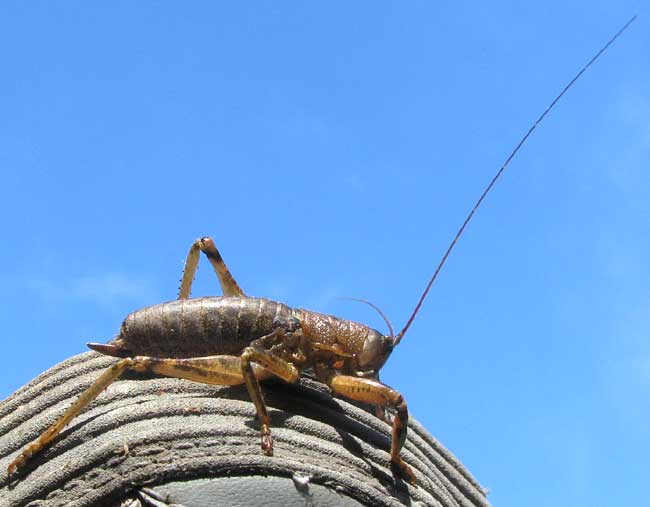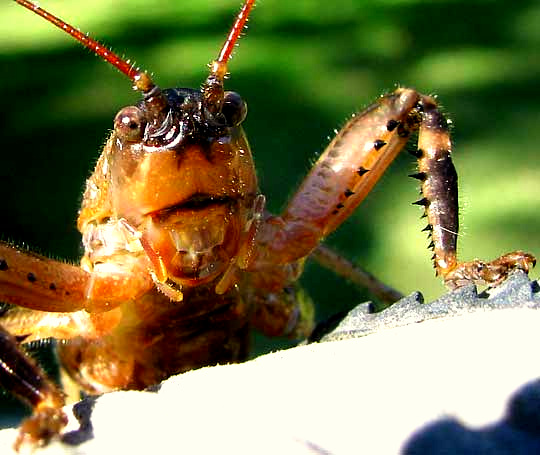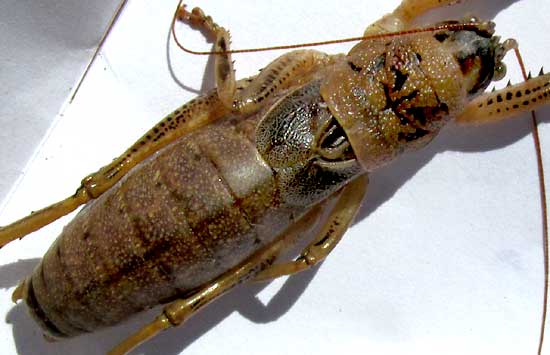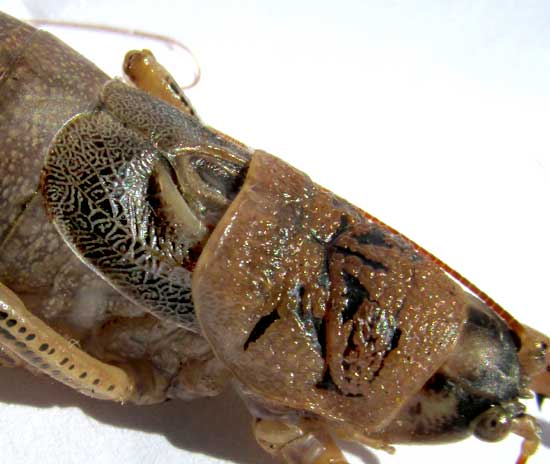Excerpts from Jim Conrad's
Naturalist Newsletter
from the November 29, 2009 Newsletter issued from Hacienda Chichen Resort beside Chichén Itzá Ruins; limestone bedrock; elevation ~39m (~128ft), N20.675°, W88.569°; central Yucatán state, MÉXICO One morning this week just after dawn I reached for a shoe and found sitting on it an orthopterid -- a member of the insect order Orthoptera, embracing crickets, grasshoppers, katydids, etc. I carried both shoe and insect outside and took the photo shown at the top of this page. Can you see what "bugged" me about this critter? I couldn't understand how it could have that short, scythe-like, egg-depositing ovipositor, indicating that it was an adult, yet also have no wings. Moreover, grasshoppers tend to have short ovipositors like this one's, but their antennae nearly always also are short. Knowing I'd be asking Bea in Ontario for help, I got her a nice close-up, which you can see below: You might be interested in Bea's procedure looking for a name. First she had to decide whether this was a cricket, katydid or grasshopper. As her deductive process got underway she boned up on the differences at BugGuide.net and let me in on what she was learning: There are individual exceptions to most of the traits above (such as a couple of species of Grasshopper with long antennae), but the generalities stated usually work and exceptions tend to be few. After a couple of days of hard work, Bea wrote: "Here is what I'm sure of so far: Order: Orthoptera (Grasshoppers, Crickets, Katydids) Suborder: Ensifera (Long-horned Orthoptera) Pretty sure: Family: Tettigoniidae
(Katydids) I'm guessing Subfamily Tettigoniinae - Shield-backed Katydids" And that's as far as we got. We got our heads more organized about the Orthoptera, though. *UPDATE: Since 2009, the availability of identification resources has increased enormously. In 2024, I find that our photos show NESOECIA NIGRISPINA, with no English name, endemic just to the Yucatan Peninsula and a bit into southern Mexico. In the 2022 study by Olga Korsunovskaya and Rustem Zhantief entitled "Acoustic and vibrational signaling in true katydid Nesoecia nigrispina: three means of sound production in one species," describes them as large, earthy colored katydids with abbreviated wings, and the authors say that relatively little is known about the biology of true katydids, of which Nesoecia nigrispina is one. They write: "The lifetime of one generation is about a year, but in nature its duration is apparently shorter, because in the last 1–1.5 months of life, the insects become inactive, sedentary and often lose one or two legs, obviously, it makes them an easy prey for predators." All illustrations in the above study show individuals with very short wings like ours, so I assume that our photos are showing the adult state.
AN (ALMOST) WINGLESS BUT ADULT KATYDID

GRASSHOPPERS:
KATYDIDS:
CRICKETS:
from the June 5, 2016 Newsletter issued from Hacienda Chichen Resort beside Chichén Itzá Ruins; limestone bedrock; elevation ~39m (~128ft), N20.675°, W88.569°; central Yucatán state, MÉXICO
SHORT-WINGED KATYDID ENCOUNTER #2
My friend Iolanda brought me an envelope in which she'd plopped a plump, grasshopper-like critter found on a wall in a room she was cleaning.
"It doesn't fly, doesn't jump, just crawls along like something is wrong with it, and I've never seen anything like it," she explained, concern in her face for what seemed a sick insect. Below, you can see the captive, whose body was about two inches long (5cm):

I couldn't figure it out. One confusing feature was that, though it looked like a fat grasshopper, its antennae were too long and slender. However, what really caught my eye was that it didn't seem to bear wings. Below, look at the top view of its body:

It does have those transparent-looking veiny items extending from behind the saddle-like area behind the head -- the prothorax -- but they certainly aren't large enough to propel such a thick, heavy creature through the air. A much closer look at them and the prothroax is shown below:
